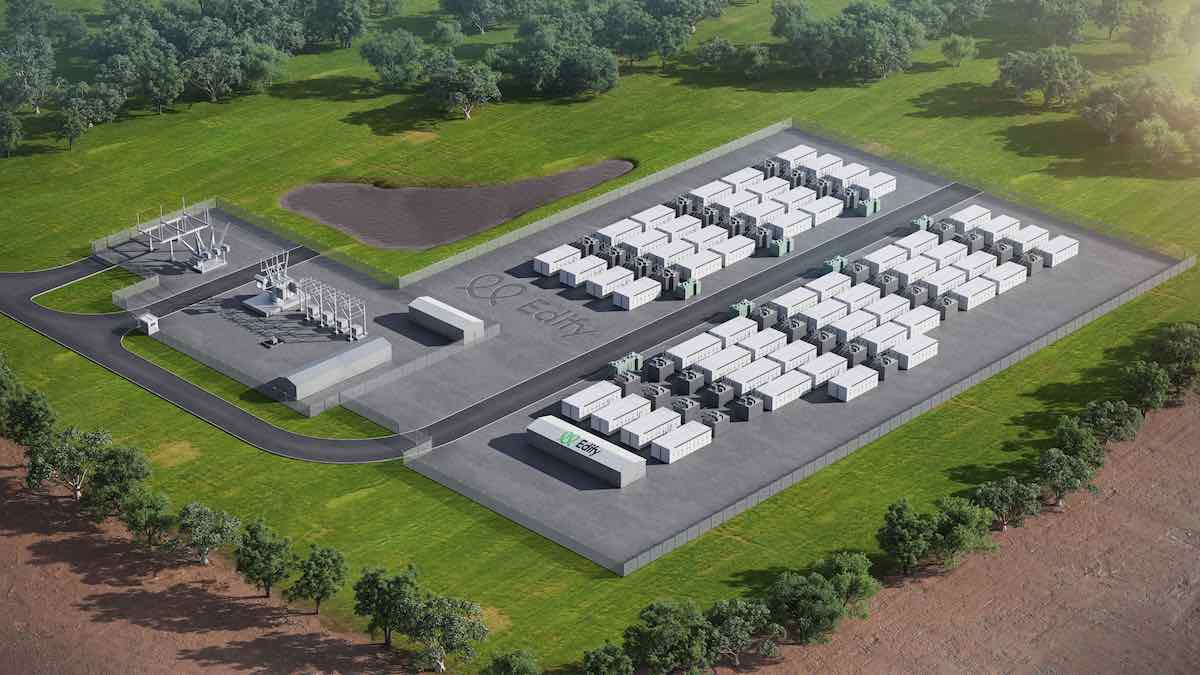One of the new giant batteries to be built in Victoria as part of the state’s newly announced storage target marks one of the most significant steps towards a truly 100 per cent renewable grid – not because of its size, but because of what it can do.
The Victoria government announced funding for two new batteries on Tuesday – a 125MW/250MWh battery at Koorangie to be built by Edify Energy near the town of Kerang in north-west Victoria, and a 100MW/200MWh battery at Tareng in the state’s south west to be built by FRV.
It’s the Koorangie battery that is of most interest, because it represents the first battery in the world – as far as we can tell – to be contracted to provide “system strength” services to a key part of the Victorian grid.
Its focus will be on the West Murray region, dubbed several years ago by RenewEconomy as the “Rhombus of Regret” because of the shape of the local network and the massive congestion problems and delays that affected many new wind and solar projects.
One of the solutions to that problem is to provide “system strength” to support the increase in renewables capacity. System Strength is a key property that enables the grid to manage major disturbances.
The significance of the Koorangie battery is that it beat out competing offers from another traditional technology – “synchronous condensers” – which mimic the system strength services provided by the spinning machines of coal and gas generators, but without burning any fuel.
Syncons, however, are essentially one-trick ponies, and batteries can do many different things at the same time, such as energy arbitrage, frequency control and inertia.
And the fact that the Australian Energy Market Operator, along with the state government and the local network operator has recognised this, is deeply significant.
“In a head to head tender against synchronous condensers for these services, a battery came out on top,” Edify Energy’s head of energy markets Andrew Stiel told RenewEconomy.
“This is pleasing to see. From a sector perspective, it shows the market operator, the network operator and the government have embraced this technology as a solution to provide these services to the system.
“This is a really important project to the changing nature of the grid,” Stiel said. “It means we will not be beholden to keep fossil fuel plants on line just for system security services. It enables us to manage the transition to a truly 100 per cent renewable system that predominantly inverter based.”
The way the battery will operate will be quite unique. It will enter a contract with AEMO to provide its 125MW capacity for system security purposes.
When called upon, it will react in a matter of milliseconds, so it will not need to draw on its two hours of storage. That capacity can still be used for other services such as energy arbitrage and frequency control and the like.
“From a day to day market perspective, the dispatch won’t look fundamentally different,” Stiel says.
“The battery will provide an intrinsic property, a background stability service. It is the mere presence of the battery (with those properties) in that region that allows the renewables hosting capacity of that network to increase and to maintain stability.”
AEMo has previously identified batteries with advance inverters, or grid forming inverters, as the key to the transition to a renewable grid.
In South Australia, it has dramatically reduced the need for gas generators to operate and provide system strength by installing a series of four syncons, but the significance of this deal with Edify is that future contracts can be done with batteries, which can deliver multiple other services at the same time.
The value of the contract released by the Victorian government is for $119 million over 20 years, but it is not clear if that is the payment to be made to Edify for the battery contract over that time, or the total cost to AEMO of managing system security in that region.
The Koorangie battery is expected to be built by 2025, and Edify has indicated that it may expand the capacity of the project to 180MW, with two hours storage.
Edify has yet to contract the supplier, although the bulk of its battery projects to date – Gannawarra and the newly announced Riverina and Darlington Point projects (illustrated above) – have been supplied by Tesla.
See also: Big Battery Storage Map of Australia










